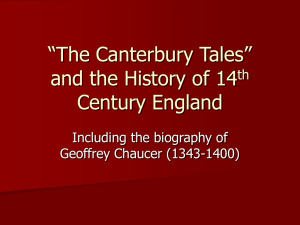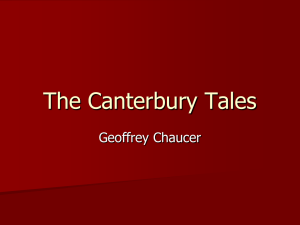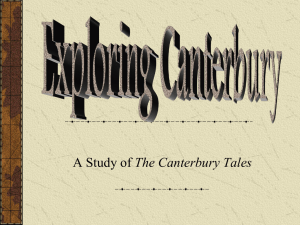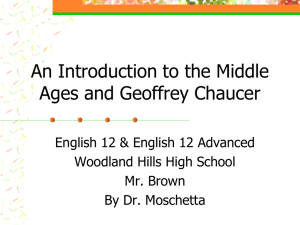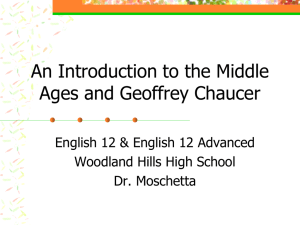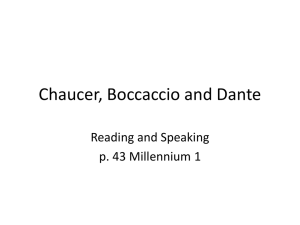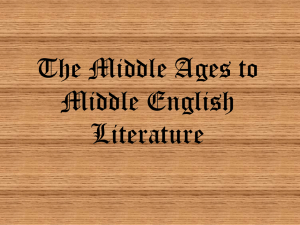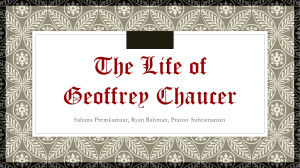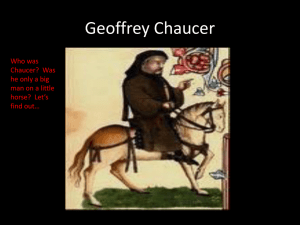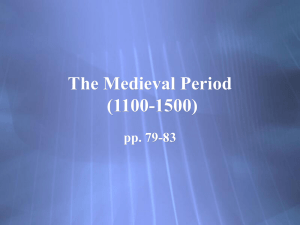The Parson`s Tale ppt 12-7-12 - English 630
advertisement
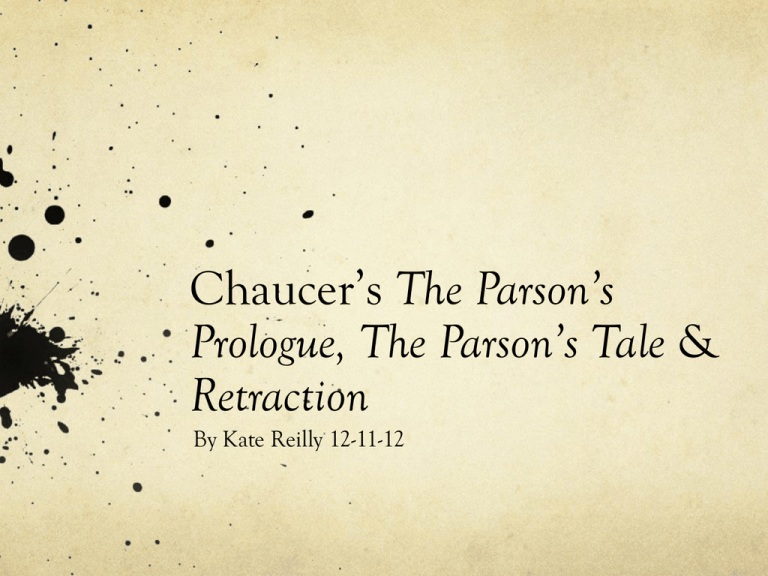
Chaucer’s The Parson’s Prologue, The Parson’s Tale & Retraction By Kate Reilly 12-11-12 Aren’t we glad for Larry Benson? Above pictures are a manuscript page of the Parson’s Tale: Canterbury Tales. Folio #: fol. 271r Bodleian Library, University of Oxford http://www.bodley.ox.ac.uk/ Retrieved from ArtStor 12-7-12 The Parson: ‘Ideal Priest’ “Our Host answerde, “O Jankin, be ye there?/I smelle a Lollere in the wynd,” quod he.” (II.B.1172-3) “Sire preest,” quod he, “artow a vicary?/Or arte a person? Sey sooth, by thy fey!/Be what thou be, ne breke thou nat our pley;/For every man, save thou, hath toold his tale./Unbokele and shewe us what is in thy male;/For trewely, my thynketh by thy chere/Though sholdest knytte up wel a greet mateere./Telle us a fable anon, for cokes bones!” (X.I.23-29)(p287) The Tree of the Seven Deadly Sins 4) Medallion, inscribed VITIA UOLU(N)TATIS, issuing branches of seven medallions, inscribed SUP(ER)BIA, INUIDIA, IRA, ACCIDIA, AUARICIA, GULA, and LUXURIA. Tree of Seven Vices of the Will (Tree of Seven Deadly Sins). The Parson’s Prologue The sonne for the south lyne was descended/ So lowe that he nas nat, to my sighte, Degreës nyne and twenty as in highte. Foure of the clokke it was tho, as I gesse, For elleven foot, or litel moore or lesse, My shadwe was at thilke tyme, as there Of swiche feet as my lengthe parted were In sixe feet equal of proporcioun. Therwith the moones exaltacioun— I meene Libra—alwey gan ascende As we were entryng at a thropes ende; (X.I.1-12) The Parson’s Prologue (cont’d) “And therfore, if yow list—I wol nat glose— I wol yow telle a myrie tale in prose To Knytte up al this feeste and make an ende. And Jhesu, for his grace, wit me sende To shewe yow the wey, in this viage, Of thilke parfit glorious pilgrymage That highte Jerusalem celestial. And if ye vouche sauf, anon I shal Bigynne upon my tale, for which I preye Telle oure avys; I kan no bettre seye. But natheelees, this meditacioun I putte it ay under correccioun Of clerkes, for I am nat textueel; I take but the sentence, trusteth weel. Therfore I make protesacioun That I wol stonde to correccioun.” (X.I.45-60) The Parson’s Tale Stylistically: The tale is awkward and appears to have faulty transitions and blatant errors. Various suggestions have been made to account for this: including Chaucer’s hasty work, the poor sources he may have drawn from, or a hasty translation and compression from a much longer source. Date: No one is clear on whether the Tale was written early in Chaucer’s composition of the Tales or later on. Various arguments have been made according to the use of prose and the pronouns Chaucer uses, but these also lead to further questions with unclear answers. Biblical References: although uninteresting, there seem to be little evidence that the Parson’s citations are incorrect. In fact, he seems to be the most correct of the pilgrims when it comes to citing the Bible. The Parson’s Tale (cont’d) Part 1: Speces of Penitence Solempne (Solitary) Commune (Community) Pryvee (Private—the everyday) 3 Parts of Penitence: 1) contrition of heart: Man must learn: What is contrition What moves a man to contrition How to be contrite What kind of contrition is available to the soul 2) confession of mouth 3) satisfaction [werkynge of manere humylitee] Part 2: Confessiontruthful revelation of sinner’s sin to priest Sin: product of a struggle between body and soul for dominance of person 2 types of sins: Venial (smaller, minor sins) and Deadly (serious sins) Part 3: 7 Deadly Sins: Branches of a Tree Pride is the worst, and therefore the trunk Ire, Lechery, Envy, Sloth, Avarice, and Gluttony are the remaining six For each sin there is a spiritual remedy Rules for Confession: Various conditions to penitence The Parson’s Tale (cont’d) “For which Crist seith in his gospel, “Dooth digne fruyt of Penitence”; for by this fruyt may men knowe this tree, and nat by the roote that is hyd in the herte of man, ne by the braunches, ne by the leves of Confessioun.” (X.I. 114 Parson’s Tale p289). “For soothly ther is nothyng that savoureth so wel to a child as the milk of his norice, ne nothyng is to hym moore abhomynable than thilke milk whan it is medled with oother mete./Right so the sinful man that loveth his synne, hym semeth that it is to him moost sweete of any thing;/but fro that tyme that he loveth sadly oure Lord Jhesu Crist, and desireth the lif perdurable, ther nys to him no thing moore abhomynable.” (X.I.121-23) (Parson’s Tale 289). The Retraction Here taketh the makere of this book his leve. Now preye I to hem alle that herkne this litel tretys or rede, that if ther be any thynge in it that liketh hem, that therof they thanken oure lord Jhesu Crist, of whom procedeth al wit and al goodnesse. And if ther be any thyng that displese hem, I preye hem also that they arrette it to the defaute of myn unkonnynge, and nat to my wyl, that wolde ful fayn have seyd bettre if I hadde had konnynge. For oure book seith, al that is writen is writen for our doctrine, and that is myn entente. Wherfore I biseke yow mekely, for the mercy of God, that ye preye for me that Crist have mercy on me and foryeve me my giltes; and namely of my translacions and enditynges of worldly vanitees, the whiche I revoke in my retracciouns: as is the book of Troilus; the book also of Fame; the book of the XXV. Ladies; the book of the Duchesse; the book of Seint Valentynes day of the Parlement of Briddes; the tales of Caunterbury, thilke that sownen into synne; the book of the Leoun; and many another book. If they were in my remembrance, and many a song and many a leccherous lay; that Crist for his grete mercy foryeve me the synne. But of the translacion of Boece de Consolacione, and othere bookes of legendes of seintes, and omelies and moralitee, and devocioun. That thanke I oure lord Jhesu Crist and his blisful mooder, and alle the seintes of hevene, bisekynge hem that they from hennes forth unto my lyves ende sende me grace to biwayle my giltes, and to studie to the salvacioun of my soule, and graunte me grace of verray penitence, confessioun and satisfaccioun to doon in this present lyf, thurgh the benigne grace of hym that is kyng of kynges and preest over alle preestes, that boghte us with the precious blood of his herte; so that is may been oon of hem at the day of doom that shulle be saved. Qui cum patre et spiritu sancto vivit et regnat deus per omnia secula. Amen. Heere is ended the Book of the Tales of Caunterbury, compiled by Geffrey Chaucer, of whos soule Jhesu Crist have mercy. Amen. Common Critical Trends The Parson’s Tale is a blight upon an otherwise exemplary literary career. Does the Retraction belong there? Parson as satirical foil for other characters. Retraction and Parson’s Tale as meant to coincide, Chaucer as exemplary sinner Retraction as Retrospective key to examine/unlock the previous tales Retraction as literary convention to encompass one’s own literary career. Dee Dyas: Pilgrimage in Medieval English Literature, 700-1500. Presents the role of pilgrimage in context of the Parson Place Pilgrimage v. Life Pilgrimage Place: physically visiting a destination, as a penance and/or for healing Life pilgrimage: going about the journey of one’s daily spiritual life so that at the end one’s soul might reach the holy Jerusalem. Suggests question is pertinent in order to situate a. the Parson and b. Chaucer’s intention for audience. Question of place pilgrimage itself was controversial not just for Wycliffites, but also for orthodox. Pilgrimage as dangerous physically and spiritually. Rewards may not be high enough. “I intend to demonstrate that Chaucer was not forced, nor is he forcing his audience to choose between place pilgrimage and life pilgrimage— between, as it were, Canterbury and the New Jerusalem. It is my contention that he offers instead a third way, which is neither worlddenying nor sin-affirming, a way which corresponds to a marked degree with that advocated by Langland in Piers Plowman.” (172) Dyas (cont’d) “…Chaucer was seeking to establish a particular correlation between place pilgrimage and the pilgrimage of life, that the presentation of the pilgrims’ quest to encounter a saint becomes a commentary upon the reality of their desire to encounter God, and that the function of the Parson’s Tale is in fact to reiterate a well-established association between the pilgrimage of life, the seven deadly sins and the sacrament of penance…” (174). “The interaction of the pilgrims on the journey to Canterbury can therefore be seen to function as a revelation of the true state of their daily pilgrimage though life. Some of those on the Canterbury road are escaping responsibility; some, like the Parson are integrating place pilgrimage into a daily life of obedience. When the Parson’s Tale is reached, it is thus already apparent how many of these pilgrims badly need his instruction if they are eventually to reach the heavenly Jersualem.” (176) James Dean: “Chaucer’s Repentance: A Likely Story” “Everyone else seemed to be doing it in their narratives, especially who, like Mandeville and Langland, committed themselves to a lifelong work. Chaucer, however, who wrote man works during his literary career, both participates in the thematic pattern and alters it somewhat.” (65) “In the Canterbury Tales Chaucer realizes his frame as a journey, specifically a pilgrimage, in which pilgrims tell stories, and at the end of which the Parson outlines the meaning and stages of penitence; and Chaucer offers his own version of penance through the Retraction. What is missing at closure is explicit mention of old age, sickness, seeking rest, are Gascoigne’s deathbed repentance. Otherwise, the pattern of the Canterbury Tales resembles the journeying, storytelling, and illness/penitence of Deguileville’s Pelerinage, Mandeville’s Travels, Langland’s Piers Plowman, or Gower’s Confessio Amantis.” (71) Dean, (cont’d) “It is quite possible, I submit, that Chaucer would have ended the Canterbury Tales in much the same way even if he had completed the whole book...” (72) “In saying that Chaucer wanted the Parson’s Tale and Retraction as the final word in the Canterbury Tales, I do not mean that it (or they) should be considered the only word. The Parson’s Tale does not negate or render worthless the other stories in the Canterbury book. The Parson’s voice in another voice—but an exceptional, authoritative voice—on the pilgrimage.” (72) “In any event, the Ricardian pattern of sickness, pilgrimage, and penitence shows why Gascoigne’s narrative of Chaucer’s deathbed repentance is a likely story—at least, not quite as unlikely as it might at first appear.” (75) Paul Strohm: Theory and the Premodern Text “In the third place, and here I am quoting from Freud, “the thought seeks to wrap itself in a joke because in that wayit recommends itself to our attention...because this wrapping bribes our powers of criticism and confuses them. We are inclined to give the thought the benefit of what has pleased us in the form of a the joke” (Jokes, 132).” (175) “All of us got here by being, at one time or another in our lives, good readers, and one definition of a ‘good reader’ is that he or se follows the instructions of the text.” (175) “But I want to speak for the occasional importance of resisting a text’s instructions—in this case, to push past the joke’s screens, to refuse to be distracted by its teller or its immediate topic or its wit from the ramifications of its thought.” (175) Questions See handout Bibliography Chaucer, Geoffrey. The Canterbury Tales. Edt. Larry Benson. The Riverside Chaucer: New Edition. Houghton Mifflin Company: Oxford © 1987. Dean, James. "Chaucer's Repentance: A Likely Story." The Chaucer Review 24.1 (1989): 64-76. Web. yas, Dee. Pilgrimage in Medieval English Literature, 700-1500. D.S. Brewer Inc.: 2001. Text. Finlayson, John. "The Satiric Mode and the "Parson's Tale"." The Chaucer Review 6.2 (1971): 94-116. Web. McGerr, Rosemarie Potz. "Retraction and Memory: Retrospective Structure in the Canterbury Tales." Comparative Literature 37.2 (1985): 97-113. Web. Strohm, Paul. Theory and the Premodern Text. University of Minnesota Press. Minneapolis: 2000. Text. Twu, Krista Sue-Lo. “Chaucer’s Vision of the Tree of Life: Crossing the Road with the Rood in the ‘Parson’s Tale’.” The Chaucer Review, 39:4 (2005): 241-378. Web. Watson, Nicholas. "Chaucer's Public Christianity." Religion & Literature 37.2 (2005): 99-114. Web. Watson, Nicholas. “The Politics of Middle English Writing”. The Idea of the Vernacular. Ed. by Jocelyn Wogan-Browne, et al. Pennsylvania State University Press. University Park: 1999. Pages 331-352. Text. Wolfe, Mattew C. “Placing Chaucer’s “Retraction” for a Reception of Closure”. The Chaucer Review 33:4 (1999): 427-431. Web.
